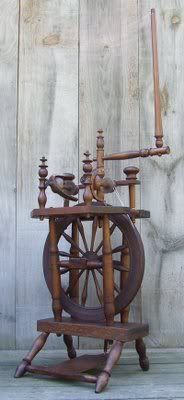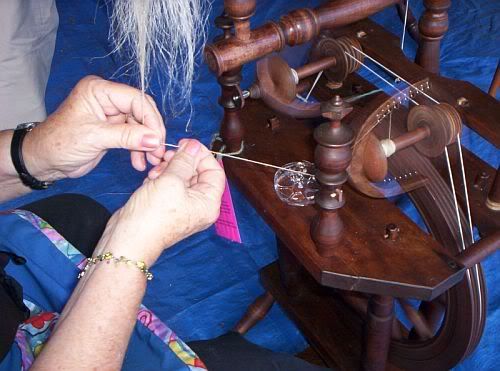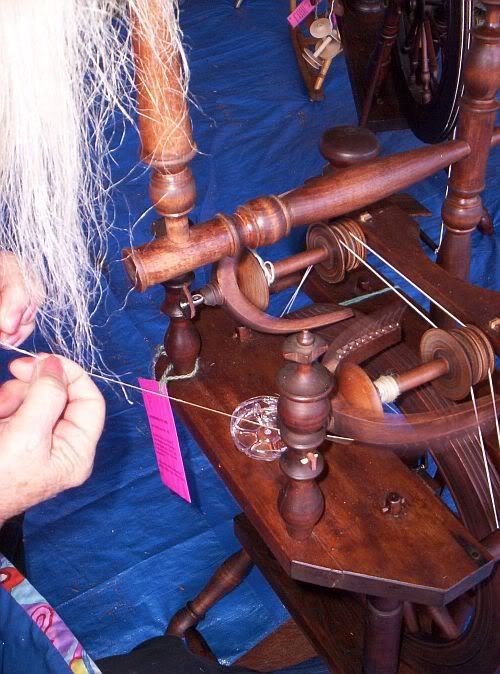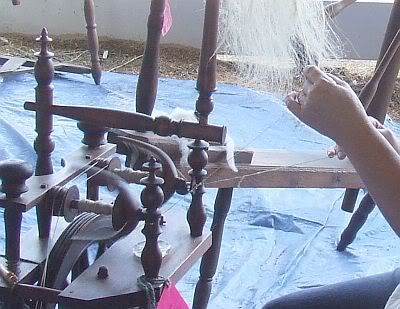
A long time ago, Beardsley Sanford (1790-1868) made this spinning wheel, and signed it. This past weekend at the PA Endless Mountains Fiber Festival, I had a chance to spin flax on it. What a challenge! What fun!
Fred Hatton restored this wheel to working condition, and did a beautiful job. The wheel is gorgeous. The first time I tried spinning on it, I was having trouble drawing the flax down.
Another spinner and friend of mine, Freda, had come by to see if we could get it going. I told her that I was having trouble dressing the distaff, and just at that moment, Pam Mawhiney from the Home Textile Tool Museum had stopped by Grace and Fred's Antique Spinning Wheel Booth to drop off some brochures. Freda asked her if she would help us out. Within a few moments she had the flax dressed on the distaff. Freda gave it go first.
Freda gave me some good pointers. She has spun more flax that I have...and she showed me how to spin it wet. Grace gave us a little water cup that she quickly made out of the bottom portion of a water bottle. It is shown sitting in the middle of the table on the wheel. I think it looks like a little crystal bowl!
Freda and I spun for a little while, side by side, "Gossip Wheel" style. We spun our flax wet, dipping our hands in the water from time to time to smooth down the loose ends of the flax before we wound onto the bobbins. We both agreed that it was fun, but most likely, not what the wheel was truly made for.
This wheel was made to spin flax with both hands at the same time- by one person. One hand for each flyer. Oh my!
Thanks to Grace and Fred, and Pam and Freda...I was able to get it going, but I spun the flax dry.
I admit it took some concentration, no "zoning out" for this wheel. It is a mystery to me how one would be able to spin and wet the flax on this wheel. Any suggestions? Any documentation? Oh, if only they could talk!
As a post script to this entry.. Grace made a video of me spinning on the wheel. You can see that there is very little time for hands to dip into a water pot!







18 comments:
Wow, two at one time? Crikey, I bet that took some doing, but it would definitely speed up production.
It is a beautiful wheel and as I told Grace, I am sorry I missed seeing it used the way it was made to be used. Glad you had a fun weekend.
This is a great looking wheel Cyndy. This fellow made something beautiful as well as functional. What fun to be able to spin on history.
hee, i did think it was a crystal bowl :-)
Yikes! TWO hands going at once?!??? I would love to see someone with that proficiency today. Any of those bast-type fibers and I'm all thumbs. :P
Amazing! I always learn something new from you!
I can't imagine how well I could spin two at a time. I find when I multitask I do a half-*ssed job on at least one thing. I wonder if these were actually more of a novelty than a production tool.
I can't imagine how well I could spin two at a time. I find when I multitask I do a half-*ssed job on at least one thing. I wonder if these were actually more of a novelty than a production tool.
Two at a time off of one distaff? I would have to really get in the zone to even attempt such a thing! And dry? Wow.
Although - your post has me wanting to get out my tow flax, blend it with some wool and spin it up.
I see that your keeping things going at a fast pace :o)
Also wanted you to know I gave you a blog award on my site today. Ginny
Wow! That's incredible- 2 bobbins at the same time. One eyeball on each?? The top photos look like someone is spinning their own hair. Is that your recently harvested flax you are using?
Perhaps, in a world with fewer distractions, in a simpler time. I'll bet the answer is practice.
How did they let go to wet one hand then the other?
The editor of the Spinning Wheel Sleuth said the "milking the cow" motion is the way she has heard it was done, but no one can figure out how to wet the flax and smooth it since you can't let go of the fiber with either hand.
You might not want to hear this, but here it is...I've heard tell that some spinners leaned over, spat on their fingers, and used that to "wet" the flax. You could do that without removing one hand.
A more ladylike (and less gross) approach would be to stop treadling, hold both threads in one hand, use the other hand to wet things, and start again. I don't think, in any case, that people always spun flax wet. Nor did they always spin flax that way--two handed wool spinning is also pretty productive!
Thanks for commiserating with me on my blog...how did you get into doing commission work? pm on ravelry and tell me about it sometime?
Very interesting! Thanks for such good photos. If you learn anything more, please post it for the rest of us!
I would imagine that if one wanted to spin flax wet on that wheel, that's what child labor was for!
A young girl who hadn't yet become proficient at spinning would watch and learn and wet her fingers to smooth the flax to let it wind on to the bobbin.
I showed this post to my daughter over the weekend. She was truly impressed. Her training is in process improvement, so I listen when she makes a suggestion. Her suggestion to wet the flax was to have something that would remain wet in the palm of your hand. Since we could not think of a way to get that something to 'stick' to your hand, I came up with the idea of wrapping wet rags around your palms. You would have to rewet them now and then, but it would put the wettness close to where you are holding the flax. The true skill involved would be to have the flax tow not stick to the rag, so this may not work. Maybe there is an extra squeeze in that milking the cow motion, to get moisture on the fiber.
This led me to thinking about the times that this wheel would have been used, IE no air conditioning. I think the wet rags around the wrists/palms would also serve to cool the spinner. This leads me to think maybe spinning flax was a summer time task, and spinning wool, a winter task. Not much different than we often spin now!
It always makes me sad to think that these type of daily life things were so routine that no one thought to archive the techniques. On the other hand it is wonderful that today we have such good archival techniques.
I bet the bottom line to this was the flax was not spun wet, but was spun and skeined dry and then wet very thoroughly and placed on the yarn skeiner to dry, especially since most flax spun was used to weave.
Hi!
My mom has a wheel that looks very much like yours. She has been a spinner and weaver since 1976. She needs to get a replacement bobbin for her spinning wheel. Do you know where she could look to get one? I have tried searching on the internet but am hitting a brick wall. If you could point me in the right direction, I would appreciate it. Thanks!
P.S. nice spinning on the youtube!
Helen
Post a Comment